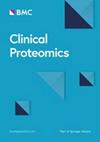Frozen tissue coring and layered histological analysis improves cell type-specific proteogenomic characterization of pancreatic adenocarcinoma
IF 3.3
3区 医学
Q2 BIOCHEMICAL RESEARCH METHODS
引用次数: 0
Abstract
Omics characterization of pancreatic adenocarcinoma tissue is complicated by the highly heterogeneous and mixed populations of cells. We evaluate the feasibility and potential benefit of using a coring method to enrich specific regions from bulk tissue and then perform proteogenomic analyses. We used the Biopsy Trifecta Extraction (BioTExt) technique to isolate cores of epithelial-enriched and stroma-enriched tissue from pancreatic tumor and adjacent tissue blocks. Histology was assessed at multiple depths throughout each core. DNA sequencing, RNA sequencing, and proteomics were performed on the cored and bulk tissue samples. Supervised and unsupervised analyses were performed based on integrated molecular and histology data. Tissue cores had mixed cell composition at varying depths throughout. Average cell type percentages assessed by histology throughout the core were better associated with KRAS variant allele frequencies than standard histology assessment of the cut surface. Clustering based on serial histology data separated the cores into three groups with enrichment of neoplastic epithelium, stroma, and acinar cells, respectively. Using this classification, tumor overexpressed proteins identified in bulk tissue analysis were assigned into epithelial- or stroma-specific categories, which revealed novel epithelial-specific tumor overexpressed proteins. Our study demonstrates the feasibility of multi-omics data generation from tissue cores, the necessity of interval H&E stains in serial histology sections, and the utility of coring to improve analysis over bulk tissue data.冷冻组织取芯和分层组织学分析改进了胰腺腺癌细胞类型特异性蛋白质组学特征描述
由于细胞群高度异质性和混合性,胰腺腺癌组织的 Omics 表征非常复杂。我们评估了使用抽芯方法从大块组织中富集特定区域,然后进行蛋白质组分析的可行性和潜在益处。我们使用活检三连抽提(BioTExt)技术从胰腺肿瘤和邻近组织块中分离出上皮富集和间质富集的组织核心。组织学评估在每个核心的多个深度进行。DNA测序、RNA测序和蛋白质组学研究均在取芯和块状组织样本上进行。根据分子和组织学综合数据进行了监督和非监督分析。在整个组织中,不同深度的组织核心具有混合的细胞组成。与切面的标准组织学评估相比,组织学评估的整个组织核心的平均细胞类型百分比与KRAS变异等位基因频率有更好的关联。根据序列组织学数据进行的聚类将癌核分为三组,分别富含肿瘤上皮细胞、基质细胞和尖突细胞。利用这种分类方法,大块组织分析中发现的肿瘤高表达蛋白被归入上皮或基质特异性类别,从而发现了新的上皮特异性肿瘤高表达蛋白。我们的研究证明了从组织核芯生成多组学数据的可行性、在连续组织学切片中间隔H&E染色的必要性,以及核芯分析在改进批量组织数据分析方面的实用性。
本文章由计算机程序翻译,如有差异,请以英文原文为准。
求助全文
约1分钟内获得全文
求助全文
来源期刊

Clinical proteomics
BIOCHEMICAL RESEARCH METHODS-
CiteScore
5.80
自引率
2.60%
发文量
37
审稿时长
17 weeks
期刊介绍:
Clinical Proteomics encompasses all aspects of translational proteomics. Special emphasis will be placed on the application of proteomic technology to all aspects of clinical research and molecular medicine. The journal is committed to rapid scientific review and timely publication of submitted manuscripts.
 求助内容:
求助内容: 应助结果提醒方式:
应助结果提醒方式:


